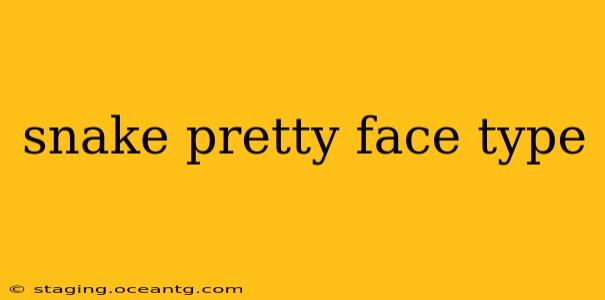Decoding the "Snake Pretty Face Type": Exploring Beauty Standards and Cultural Influences
The term "snake pretty face type" is intriguing and somewhat ambiguous. It doesn't refer to a scientifically defined category, but rather a subjective aesthetic ideal circulating online, primarily within East Asian beauty standards. It likely points to facial features reminiscent of a snake's elegant and often striking characteristics. This post will delve into the possible interpretations, analyze the cultural context, and address some common questions surrounding this aesthetic.
What are the characteristics of a "snake pretty face type"?
The "snake pretty face type" is generally associated with specific facial features that evoke a sense of delicate elegance and allure. These often include:
- Sharp, defined features: High cheekbones, a sharp jawline, and a pointed chin are frequently cited. These features create a more angular face shape, contrasting with rounder, softer features.
- Long, slender face: A longer face with a relatively smaller width contributes to the overall sleek appearance.
- Narrow eyes (sometimes upturned): While not exclusively defining, narrow eyes, sometimes with a slight upward slant, contribute to the overall aesthetic. This feature is often associated with certain East Asian beauty ideals.
- Full lips (but not necessarily plump): The lips are typically full, but the emphasis is on their shape and definition rather than extreme plumpness. A well-defined cupid's bow can enhance this look.
- Pale or fair skin: This characteristic often complements the sharp features, creating a striking contrast.
Are there specific celebrities associated with this aesthetic?
Pinpointing specific celebrities as the perfect example of the "snake pretty face type" is subjective and depends on individual interpretation. However, many celebrities who possess some of the features mentioned above are frequently discussed in online communities. These are usually East Asian celebrities, further emphasizing the cultural context of this beauty standard. It's important to note that this is not a categorization based on any objective measurements, but rather a subjective assessment of visual characteristics.
What is the cultural significance of this "type"?
The "snake pretty face type" aligns with specific beauty standards prevalent in certain cultures, particularly East Asia. These standards often emphasize elegance, sophistication, and a certain aloofness. The snake, in some cultures, symbolizes these qualities, along with wisdom, mystery, and power. The association of these characteristics with beauty is rooted in cultural perceptions and historical representations.
How does this aesthetic differ from other beauty standards?
This "type" contrasts with other beauty ideals that emphasize rounder, softer features or more youthful, doll-like appearances. The emphasis on angularity and a certain sharpness distinguishes it significantly. It also emphasizes a particular level of sophistication and maturity in contrast to more traditionally "cute" aesthetics.
Is this beauty standard inclusive or exclusive?
Like all beauty standards, the "snake pretty face type" has implications of inclusivity and exclusivity. It can be viewed as exclusive because it emphasizes a specific set of features, potentially leaving out individuals who don't possess them. However, it also promotes a type of beauty that challenges conventional ideals, broadening the spectrum of what is considered attractive.
Ultimately, the "snake pretty face type" highlights the complex and evolving nature of beauty standards. It's a testament to the diverse perceptions of attractiveness and the cultural influences that shape our understanding of beauty. While it's a subjective term, understanding its components and context offers a fascinating insight into the ever-changing landscape of beauty ideals.
